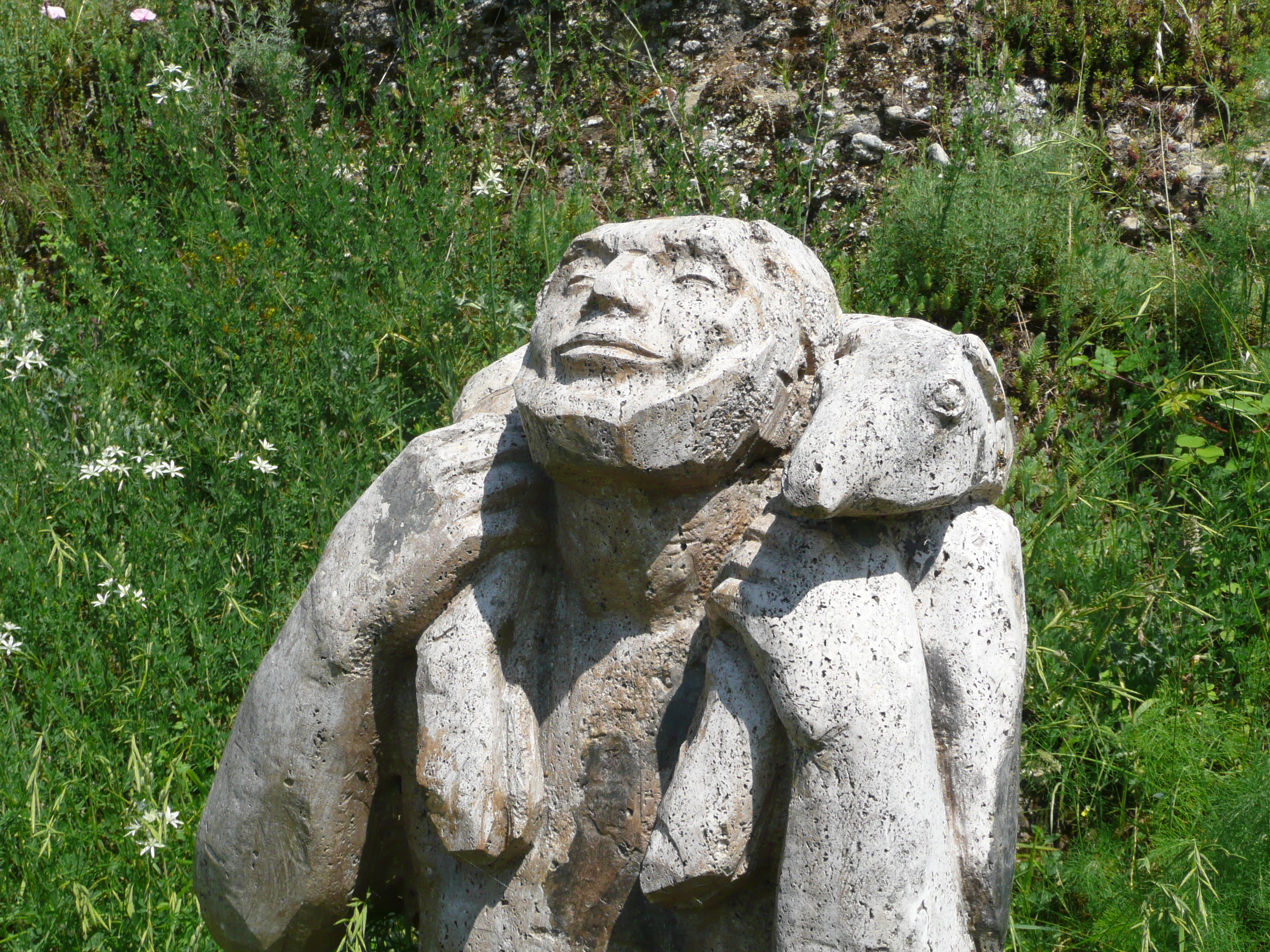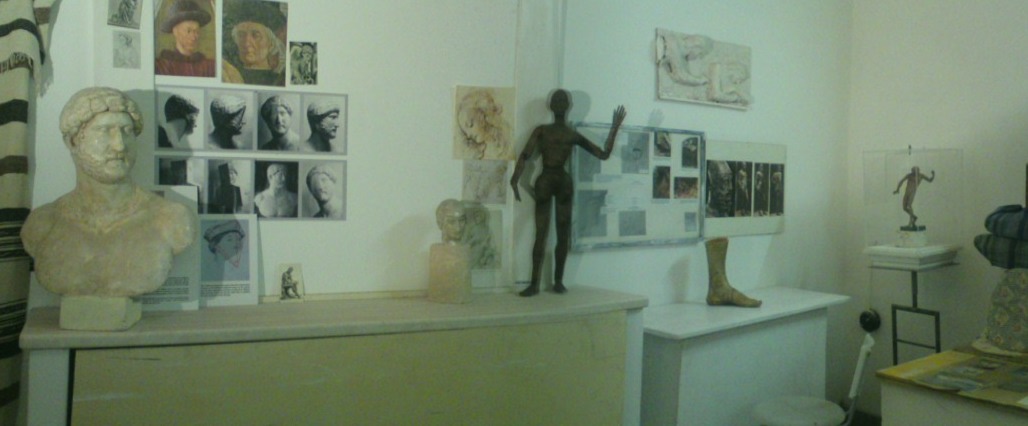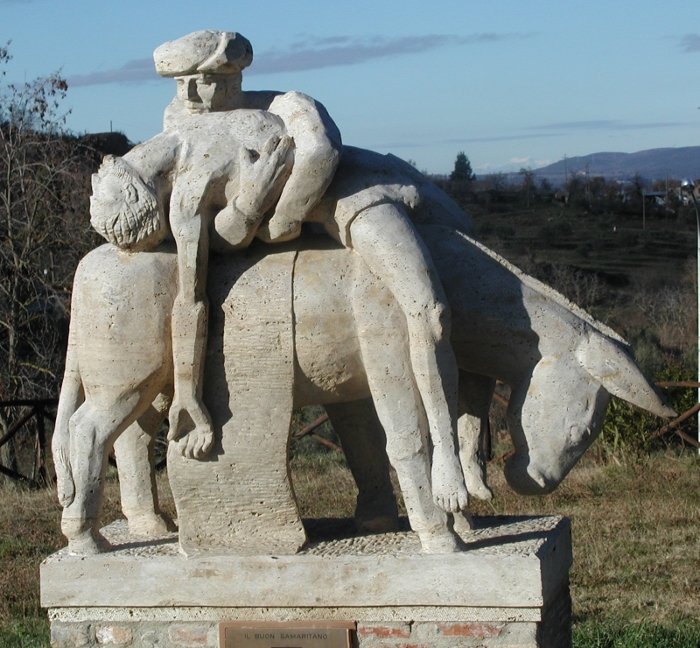Part 1 - Museum of Sculpture
In April 2012 The Misericordia of Casole d'Elsa opened a museum in honour of Nigel Konstam. The museum displays his sculpture and carvings and is a commemoration of the years Nigel has lived and worked and run his Art Centre in the beautiful Tuscan village of Casole. During this time he has enjoyed a very happy relationship with this friendly village that has commissioned a number of monumental sculptures which now adorn the village. Starting with the Crucifix by Nigel Konstam at the entrance of the village and later the Good Samaritan, a greater than life size travertine carving that adorns the green in front of church of San Nicola. Unlike most museums, however, many of the works displayed are for sale!
The Good Samaritan

Carving area

The Good Shepherd
Please Click to View Full Size
Part 2 - Museum of Artists' Secrets
The second part of the museum consists of maquettes and instruments with which Nigel Konstam made a number of important discoveries in the field of art history and archaeology. There are also a number of DVDs and documents which explain the reasoning that made him determined to suggest reforms in those faculties. Artists should again take the lead in cultural decision making.
The subjects covered in the museum are in chronological order:
Greece
- The discovery that the Greeks used life-casting (Oxford Journal of Archaeology 2004) for their life-size figures from the time of Phidias onwards.
- A chimney (OJA 2002) on the Acropolis in Athens, and another in Olympia.
-
The two discoveries above led many years later to the discovery that "The Elgin Marbles", so called because Lord Elgin rescued them from the ruins of the Parthenon, are not all Greek. Those that have won most praise are in fact Roman. The difference between the original Greek and the Roman replacements is clear. The Greek originals are all grey with black spots where the carving is deepest so the soot has penetrated the bruised stone furthest. The weathering is soft as they are 2000 years old. These qualities are most easily seen on the east pediment where the smoke rises from below. The one exception on the east pediment is the Horse of Selene which is clean shiny marble, undamaged by smoke, The west pediment is entirely Roman because closest to the chimney and therefore needed to be replaced, probably by Hadrian (117-138 AD). The damage we see in The British Museum is caused by the Venetian bombardment of 1687 therefore crisper than that on the east pediment.
These findings are important because they contradict standard opinion that Greek sculpture is superior to the Roman copies. The findings could be confirmed or disproved by comparing the soot in the chimney with that on the sculptures but these tests have not yet been done in spite of many requests.
- A method of steaming moulds to recover 70% of the wax usually lost (Sculpture the Art and the Practice), used at Rhodes and almost certainly elsewhere.
Rome
Roman geometry had an enormous influence on subsequent art that is seldom acknowledged. The analysis of a portrait bust of Hadrian in the British Museum, demonstrates this geometry (See the Youtube video (First published in Apollo in Aug 1972)). Artists who have used it since, like Mantagna, Holbein, Rembrandt and Giacometti, are also represented in the museum.

Siena
- An appreciation of the works of Rinaldo da Siena recently discovered under the cathedral.
- Reasons why the so called Duccio Window cannot be by Duccio.
- The discovery of the dimension of time in Simone Martini’s Madonna of the Annunciation.
- Lorenzo Maitani’s great work is on the facade of Orvieto Duomo 112 sq m. of relief sculpture of very high quality. We have a film showing how he was able to accurately transmit his art to his assistants.
Florence
- The probable use of a polished silver mirror in Brunelleschi’s essay in perspective (YouTube video).
- The probable use of sculptural maquettes in conjunction with mirrors by Masaccio.
- Michelangelo’s use of maquettes for preparatory drawings
- Cellini’s casting method is demonstrated to be very close to the method of Phidias.
Rembrandt
An exploration of Rembrandt's use of live models and mirrors, indicating that his contemporaries knew a Rembrandt that modern scholarship has all but destroyed; an artist whose example is very important to artists who observe life today. A much more in depth discussion can be found on Save Rembrandt.

Velasquez
Exploring the use of a large mirror from the Hall of Mirrors at the Royal Palace in Toledo for the composition and rapid completion of his most important masterpiece – Las Meninas (YouTube video)

Vermeer
Vermeer's use of two mirrors in conjunction with a camera-obscura as an aid for painting. (YouTube video)

